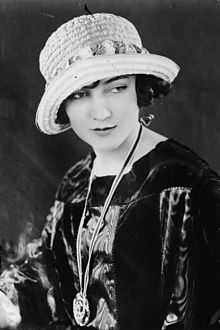Jane Winton

Jane Winton (October 10, 1905 - September 22, 1959) was a movie actress, dancer, opera soprano, writer, and painter. She was born in Philadelphia, Pennsylvania.
During the 1920s she began her stage career as a dancer with the Ziegfeld Follies.
Film actress
After coming to the west coast Winton became known as the green-eyed goddess of Hollywood. Her film appearances include roles in Tomorrow's Love (1925), Why Girls Go Back Home (1926), Sunrise, The Crystal Cup and The Fair Coed (1927), Burning Daylight, Melody of Love and The Patsy (1928), Scandal and Show Girl in Hollywood (1929), and The Furies and Hell's Angels (1930).
Winton played Donna Isobel, the mother of the title character, in Don Juan (1926). The film starred John Barrymore and Mary Astor. The movie was billed as the first film made in Vitaphone, a new invention which synchronized sound with motion pictures. Modern talking pictures began with the Vitaphone.
Opera and radio
After leaving Hollywood, Winton performed various operatic roles both in the United States and abroad. In 1933 she was with the National Grand Opera Company for their production of I Pagliacci. She sang Nedda. She starred in the operetta Caviar. In England she became noted for her singing and work in radio.
Novelist
In 1951 Winton's novel, Park Avenue Doctor, was published by Frederick Fell. Passion Is The Gale, her second novel, was released almost a year later.
Marriage
Winton married three times. In 1927 she wed Hollywood screenwriter Charles Kenyon. She married New York businessman Horace Gumble in 1930. Her last husband was Michael T. Gottlieb, a stockbroker, tournament contract bridge player, and Arizona property owner. They wed in 1935.
Death
Jane Winton died in 1959 at the Pierre Hotel in New York City. She maintained other residences in Katonah, New York and Phoenix, Arizona.
Selected filmography
- His Supreme Moment (1925)
- Why Girls Go Back Home (1926)
- Don Juan (1926)
- Across the Pacific (1926)
- The Beloved Rogue (1927)
- Sunrise (1927)
- The Fair Co-Ed (1927)
- Bare Knees (1928)
- The Patsy (1928)
- Yellow Lily (1928)
- Show Girl in Hollywood (1930)
- A Notorious Affair (1930)
- Hell's Angels (1930)
References
- New York Times, Jane Winton, 51, Actress, Singer, September 23, 1959, Page 35.
External links
|